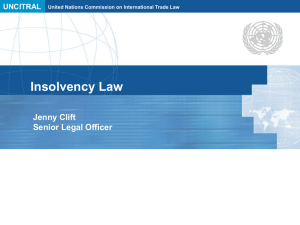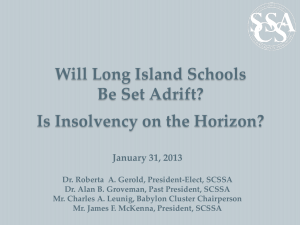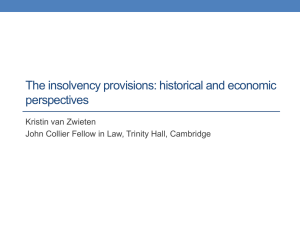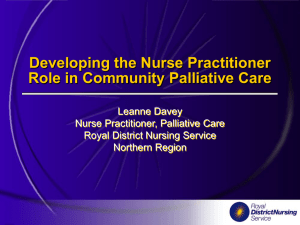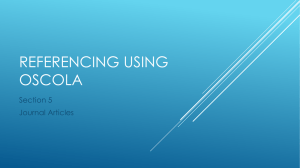Oversight regulation and monitoring in the insolvency
advertisement
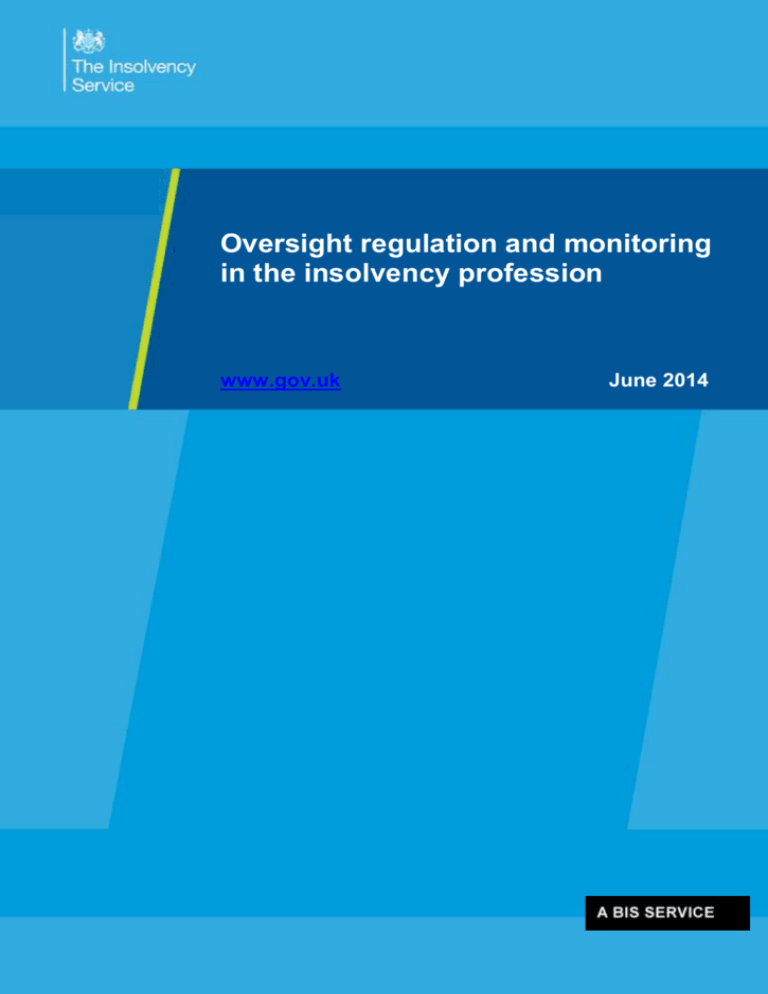
Oversight regulation and monitoring in the insolvency profession www.gov.uk June 2014 Contents 1.0 Overview 3 2.0 Aims of monitoring 2.1 Monitoring the authorising bodies 2.2 Focus of monitoring 2.3 Objectives of monitoring 4 3.0 Approach to monitoring 3.1 General approach 3.2 Risk assessment 3.3 Transparency 3.4 Stakeholder input 3.5 Regulatory outcomes 6 4.0 Complaints Processes 4.1 Oversight regulation 4.2 De-recognition of an authorising body 10 5.0 Funding oversight regulation 11 Annex 1 Overview of the regulatory regime 12 Annex 2 Annual monitoring activities 14 Annex 3 Abbreviations and reference materials 17 Annex 4 Further information and contacts 18 1 Overview The Insolvency Service provides the frameworks and delivers the public services that deal with insolvency and the misconduct that can accompany or lead to it. Our activities span personal and company insolvency, and investigations into live companies. The subject of this paper concerns a further important area for which we have responsibility - the regulatory oversight of the bodies that authorise and regulate insolvency practitioners. This document sets out the objectives and focus of the Insolvency Service’s regulation and monitoring of these bodies1. It is being issued following engagement with the authorising bodies to detail changes to the Service’s monitoring strategy, including ensuring greater publicity for outcomes. Our overarching aim is to ensure that those affected by the work of insolvency practitioners have confidence that the regulatory regime encourages best practice and deals effectively and consistently with any poor performance or misconduct. Our general approach to oversight regulation reflects the principles set out in the Regulators’ Code and aims to: maximise the effectiveness of our monitoring work. reflect best regulatory practice. ensure transparency for regulators, complainants and other stakeholders. We monitor the regulatory activities of the authorising bodies by undertaking on-site visits, desktop monitoring and themed reviews focusing on topical areas of concern. Monitoring activities and regulatory outcomes are reported in the Annual Review of Insolvency Practitioner Regulation (‘Annual Review’). The purpose of monitoring is to encourage best regulatory practice and to specifically assess compliance against the principles set out in the Memorandum of Understanding (‘MoU’) agreed with the Secretary of State as to how the authorising bodies should regulate their insolvency practitioner licence holders. Annex 1 provides an overview of the regulatory regime. Our general approach to oversight regulation should appropriately balance the needs of all those with an interest in insolvency outcomes including creditors, debtors, the authorising bodies and insolvency practitioners. Our monitoring activities are targeted to deliver transparent, accountable, proportionate and consistent oversight to ensure confidence in the regulatory regime; we do this by: using risk-assessment to ensure proportionate regulation. publicising regulatory processes and outcomes. explaining how regulatory decisions can be challenged. engaging with regulatory bodies and stakeholders. providing information on how regulation is funded. benchmarking to assess regulatory outcomes. 1 Those bodies include the 7 Recognised Professional Bodies and the Insolvency Service as a Competent Authority Regulator – see Annex 1 for further details. 3 Annex 2 summarises our general approach to monitoring, although we recognise that flexibility is needed to ensure that we can respond appropriately to new developments, intelligence and information. Annexes 3 and 4 provide links to further information and contacts, including details of how to make a complaint. 2 Aims of monitoring 2.1 Monitoring the authorising bodies Monitoring is undertaken to satisfy the Secretary of State that the authorising bodies continue to meet certain legal requirements2: that they regulate their insolvency practitioner members to ensure that they are fit and proper persons. that the persons whom they authorise to act as insolvency practitioners meet acceptable requirements as to education, practical training and experience. The standards expected of the authorising bodies are set out in the MoU, which covers matters such as the granting of authorisations, ethics and professional standards, the handling of complaints, retention of records and the disclosure of regulatory information to other bodies and the Secretary of State. A separate document, the Principles for Monitoring, sets out the matters to be considered by the authorising bodies when monitoring their insolvency practitioner licence holders. That monitoring is designed to allow the authorising bodies to make an objective assessment of the conduct and performance of insolvency practitioners and to ascertain whether an individual continues to meet the fit and proper test. The Principles for Monitoring includes guidance on the frequency of monitoring visits, key monitoring considerations, liaison between authorising bodies and recommendations as to the content and timing of written monitoring reports. In practice, oversight regulation and monitoring of the authorising bodies is undertaken by Insolvency Practitioner Regulation Section (IPRS) of the Insolvency Service. Most of the authorising bodies are also recognised by the Department of Enterprise, Trade and Investment (DETI), which exercises similar oversight regulation in Northern Ireland. Where appropriate, and to minimise regulatory burdens, joint monitoring visits are undertaken by IPRS and DETI. Monitoring focuses on the authorising bodies having appropriate processes in place to ensure that the standards and principles set out in the MoU and the Principles for Monitoring are effectively put into practice. Monitoring findings are discussed with, and reports issued to, the relevant authorising body including any recommendations made for improvements. Monitoring activities undertaken by IPRS are summarised and published each year in the Annual Review. 2 Section 391(2) of the Insolvency Act 1986. 4 2.2 Focus of monitoring The MoU and the Principles for Monitoring are important documents underpinning the regulatory regime. Assessing compliance with these documents is a fundamental part of our monitoring work. More broadly, we look at regulatory outcomes as well as processes. Regulatory outcomes we consider may include an analysis of: complaint outcomes. sanctions against insolvency practitioners. licence restrictions or revocations. outcomes of monitoring visits to insolvency practitioners. The extent and nature of our monitoring is based on risk assessment and we use themed reviews to focus on topical areas of concern. Our approach reflects best practice and developments in similar regulatory areas, such as the legal and audit professions. While direct comparisons with other regulated areas is not always appropriate, particularly given the lack of a direct client relationship in most insolvency scenarios, the use of risk assessment and a focus on outcomes are generally regarded as having a positive impact on regulatory effectiveness. Where relevant, we also adopt best practice principles from the Public Sector Internal Audit Standards. Using an outcomes and principles based approach enables our oversight role to evolve to respond to changes in regulatory and market environments; for example, developments in insolvency legislation, practice and variations in case numbers. 2.3 Objectives of monitoring Monitoring activities are designed to ensure that the authorising bodies continue to meet requirements set out in the law. Determining whether this is being achieved is assessed by reference to: compliance with the MoU and the Principles for Monitoring. application of the Insolvency Code of Ethics. delivering appropriate and consistent regulatory outcomes. responsiveness to developments in practice. The authorising bodies are required to demonstrate compliance with the MoU and Principles for Monitoring and should ensure that processes are in place to consider the ethical conduct of insolvency practitioners. Delivering consistent outcomes and responding quickly to developments in practice are important regulatory outcomes that would demonstrate an authorising body has effective processes and procedures in place to ensure that only fit and proper persons are able to act as insolvency practitioners. The authorising bodies participate in initiatives, such as the Joint Insolvency Committee, to promote consistency in regulation and raise standards across the insolvency profession. Most of the bodies are also part of the Complaints Gateway 5 operated by the Insolvency Service3. Further work remains to be done on ensuring full participation in the Complaints Gateway, the effective and consistent implementation of common sanctions guidance, the introduction of common independent reviewers for appeals and adoption of a common approach to publicity for sanctions. This will help achieve our aim of delivering consistent regulatory outcomes. 3 Approach to monitoring 3.1 Introduction To ensure an effective, proportionate and consistent approach to monitoring, we use: risk assessment to ensure that the resources of IPRS, DETI and the authorising bodies are used appropriately. publicity to ensure an awareness of the regulatory framework and outcomes. stakeholder input in considering regulatory processes and outcomes. benchmarking to ensure consistency and appropriateness of regulatory outcomes. The ways in which the authorising bodies are monitored varies according to a number of factors and will involve a mix of monitoring visits and desktop activity. Desktop monitoring may include the analysis of information received from the authorising bodies in annual and other returns, information or other intelligence received from complainants or third parties, and the consideration of any other specific issues affecting the ability of the body to operate effectively. Annex 2 summarises the different types of monitoring activity, including related processes and timescales for monitoring visits. We frequently and routinely engage with the authorising bodies and regulators in other sectors. This helps ensure a consistent best practice approach and, where appropriate, enables flows of information to reduce regulatory burdens and avoid duplication in monitoring activities. 3.2 Risk assessment Risk assessment allows regulatory resources to be targeted in a proportionate and efficient manner. Authorising bodies generally use a risk-based approach in monitoring their insolvency practitioner licence holders and visits are scheduled according to factors such as information received from complainants or an assessment of the adequacy of a firms’ compliance function. Most bodies also require that insolvency practitioners complete annual returns (certification by individuals or firms), where internal compliance checks are undertaken and reported. The Insolvency Service considers the risk profile of an authorising body in assessing the appropriate level and type of monitoring. The risk being assessed is that the 3 Bodies that participate in Complaints Gateway: the Secretary of State, Institute of Chartered Accountants in England & Wales, Association of Chartered Certified Accountants, Insolvency Practitioners Association, Chartered Accountants Ireland & Institute of Chartered Accountants of Scotland. 6 authorising body no longer continues to meet the requirements set out in the law. Given the way in which most authorising bodies have developed their own riskassessment processes, including the introduction of effective measures to ensure compliance with routine regulatory requirements, we are also able to rely on risk assessment when considering how best to use resources and target monitoring activities. There are generally few concerns across the authorising bodies about compliance with certain aspects of the MoU, particularly where those functions are of a routine or objective nature. As a result, we can rely on desktop monitoring in some areas to enable resources to be focused on more subjective, substantive or contentious matters. Risk assessment measures used to consider the nature, extent and frequency of monitoring activity include: an analysis of information provided by an authorising body about the number of authorised, and appointment taking, insolvency practitioners. an analysis of the effectiveness of monitoring processes and appropriateness of monitoring schedules. whether any complaints have been received about the authorising body and the outcome of investigations into those complaints. findings from previous monitoring visits and the extent to which recommendations have been implemented. other key events, changes or regulatory action affecting the work of the authorising body. The table below indicates those aspects of the MoU where we can place more reliance on ‘self-certification’ by the authorising bodies and those areas where more focus will be put on a monitoring visit or themed review. 7 Table 1: Style of monitoring MoU Principle Self-certification/ firm certification annual report Granting of authorisations √ Maintenance of authorisations √ Visit/ themed reviews Ethics and professional standards √ Handling of complaints √ Security and caution √ Disclosures and exchange of information √ Retention of records √ Reporting to the Secretary of State √ A reliance on risk assessment techniques should produce the following benefits: reduced focus on certain aspects of the MoU through monitoring visits resulting in shorter, less resource intensive, visits for both the authorising bodies and the oversight regulator. reduced regulatory burdens through routine desktop monitoring in low-risk areas. increased focus on topical areas of concern, and fairness and consistency in regulatory outcomes generally. 3.3 Transparency Historically, monitoring reports have only been shared with the relevant authorising body to allow for a check of factual content and for responses to any recommendations to be made. To improve transparency, we propose to publish final monitoring reports within an agreed timescale of 8 weeks following the completion of a monitoring visit. The Insolvency Service publishes an Annual Review, which includes data and information about regulatory action and oversight monitoring. From March 2015, we propose to publish more detail in the Annual Review about the outcomes of all regulatory and monitoring activities undertaken during the year. It is proposed that the expanded Annual Review will include: a report on the performance of each authorising body during the year with full details and outcomes of all monitoring activities undertaken and recommendations made. 8 statistical information relating to the number of authorisations, complaints and sanctions taken. a consideration of comparative aspects of performance. A draft copy of the Annual Review will continue to be circulated to the authorising bodies prior to publication in order to ensure factual accuracy. We will also consider responses to any recommendations made and more generally will invite feedback from the authorising bodies about the effectiveness of our monitoring processes to ensure that we use best practice methods. 3.4 Stakeholder input To ensure balance, we will seek views from a wide range of stakeholders on the effectiveness of the regulatory regime; for example, through interviews and questionnaires. Relevant parties include: insolvency practitioners, including those involved in regulatory or disciplinary processes. authorising body committee members. complainants. independent reviewers of complaints. bodies representing creditors, debtors and others will an interest in insolvency outcomes. Those involved will be asked to consider whether regulatory outcomes provided them with confidence that matters were fully and appropriately addressed by the regulatory process and, if not, what more could be done to improve confidence. 3.5 Comparing and assessing regulatory outcomes The introduction of the Complaints Gateway provides an opportunity for comparative information to be assessed about complaint handling processes and regulatory outcomes. Information about regulatory outcomes will be used to benchmark complaints, for example to assess whether complaints of a similar nature result in equivalent outcomes across different authorising bodies. One of the pre-requisites to undertaking this work will be to ensure that complaint type and outcome categories are being used in a consistent and common way across the authorising bodies. Whilst individual cases must be decided on circumstances, including evidence and any mitigating factors, there may be sufficient commonality across cases to enable meaningful comparisons to inform the monitoring of complaints handling processes and outcomes. Findings and any recommendations will be discussed with, and reported to, the authorising bodies. In addition to benchmarking of complaint outcomes, we will carry out work to help establish the level of confidence in the effectiveness of the regulatory regime. While insolvency procedures invariably involve financial loss, which is likely to influence any results, we will work with stakeholders to develop and refine appropriate measures and techniques. This activity will provide a benchmark for assessing performance and provide an opportunity for all those involved to measure and evidence any improvements in confidence. 9 4 Complaints processes 4.1 Oversight regulation Links to information about how to make complaints is set out in Annex 4. There are different ways to make complaints about insolvency practitioners, the authorising bodies and the Insolvency Service. Complaints about insolvency practitioners are made through the Complaints Gateway and dealt with by the relevant authorising body. Complaints about the processes of the authorising bodies should be sent to IPRS. IPRS will carry out an initial assessment to ensure complaints are within scope to be considered; this would, for example, preclude complaints being taken forward about insolvency law or policy. IPRS will appropriately engage with the authorising bodies as part of the process of considering and resolving such complaints. IPRS will notify authorising bodies of the outcome of its review into a complaint at the same time as informing the complainant of the decision reached. Complaints about regulatory functions within the Insolvency Service are dealt with initially within IPRS and may be passed to the Head of Insolvency Practitioner Regulation. If a complainant remains unsatisfied, the Adjudicator’s Office provides further recourse as a fair and unbiased referee, although the Adjudicator cannot consider disputes about policy or matters of law. Details of the remit of the Adjudicator’s Office are available on its website. More widely, the Insolvency Service as an Executive Agency of the Department for Business, Innovation & Skills (BIS) is accountable to Parliament through ministers and the select committee system. Day-to-day responsibilities are discharged through the Chief Executive of the Service. The Chief Executive is also supported and challenged by the Insolvency Service Board. The Board provides strategic leadership and is collectively responsible for the long-term success of the agency. 4.2 De-recognition of an authorising body Concerns about the effectiveness of processes operated by the authorising bodies are ordinarily resolved through direct engagement with the relevant body. Ultimately, if those concerns persisted and were considered to be so serious as to cast doubt on a body’s ability to fulfil its legal obligations, the Secretary of State could revoke the recognition of the authorising body. Revoking recognition would require the Secretary of State to amend secondary legislation4. If an authorising body wanted to challenge a decision of the Secretary of State to revoke its recognition, it could do so by way of judicial review whereby a judge would review the decision and order an appropriate remedy if the decision was found to be unlawful. 4 The Insolvency Practitioners (Recognised Professional Bodies) Order 1986. 10 5 Funding of oversight regulation The Insolvency Service funds its oversight regulation function through a levy on the authorising bodies, which in turn pass on those costs to their insolvency practitioner members. The costs of oversight regulation are recovered through a levy set out in a fees order5, currently set at £300 per insolvency practitioner regulated by the authorising body. The costs of operating the Complaints Gateway are recovered under the provisions of a Memorandum of Understanding agreed with participating bodies. This cost is currently set at £40 per insolvency practitioner and is reviewed periodically in accordance with the terms of the agreement. 5 The Insolvency Practitioners and Insolvency Services Account (Fees) (Amendment) Order 2009. 11 Annex 1: Overview of the insolvency regulatory regime The regulatory regime introduced by the Insolvency Act 1986 The authorisation regime for insolvency practitioners in Great Britain was introduced by the Insolvency Act 1986. Similar legislation exists for Northern Ireland but this document only covers England, Wales and Scotland6. Only individuals can be authorised to act as an insolvency practitioner. Role of the Secretary of State The Secretary of State is empowered to recognise professional bodies as being able to authorise and regulate their members to act as insolvency practitioners. These bodies have to enforce rules, which ensure that each of their members who are permitted to act as insolvency practitioners are fit and proper and meet acceptable requirements as to education, practical training and experience. The Secretary of State is also able to directly authorise insolvency practitioners. The Insolvency Service currently has two distinct roles in relation to the regulation of insolvency practitioners: Direct authorisation, which is undertaken by Insolvency Practitioner Section (IPS) to regulate those who apply directly to the Secretary of State for authorisation to act as an insolvency practitioner7. Regulatory oversight, which is undertaken by IPRS: to monitor the regulatory activities of the authorising bodies (including IPS8) to ensure that they are undertaken in accordance with common standards as set out in the MoU. to develop regulatory policy and professional standards. to provide guidance to the insolvency profession on law and practice. to monitor the effectiveness of the relevant legislation. In February 2014, the Insolvency Service launched a consultation on strengthening the regulatory framework by introducing regulatory objectives and by giving the oversight regulator a more proportionate range of sanctions to tackle poor performance or misconduct9. The Recognised Professional Bodies (RPBs) Seven bodies have been recognised by the Secretary of State to authorise their members, and other individuals under associate or affiliate schemes, to act as insolvency practitioners10. 6 Insolvency legislation is devolved in Northern Ireland, although the regulatory regime follows very closely that which applies in England, Wales and Scotland. 7 The Government has announced its intention to withdraw from this role and provisions giving effect to this are set out in the Deregulation Bill, currently before Parliament; if enacted, there will be a one year transition period to enable insolvency practitioners authorised by the Secretary of State to move to another authorising body. 8 To ensure independence, the functions of IPS and IPRS are operationally separate. 9 https://www.gov.uk/government/consultations/insolvency-practitioner-regulation-and-fee-structure 10 An individual who is authorised as an insolvency practitioner under associate or affiliate schemes is subject to the relevant RPB’s professional rules and regulations and their regulatory and disciplinary schemes. 12 Those bodies, which have been recognised since 1986, are: Institute of Chartered Accountants in England & Wales Association of Chartered Certified Accountants Insolvency Practitioners Association Law Society of England & Wales Law Society of Scotland Chartered Accountants Ireland Institute of Chartered Accountants of Scotland The Law Society and Chartered Accountants Ireland have transferred their regulatory and disciplinary functions to operationally independent bodies - the Solicitors Regulatory Authority and the Chartered Accountants Regulatory Board respectively. 13 Annex 2: Annual monitoring of the authorising bodies This schedule sets out the type of monitoring and other activities that will typically be undertaken by IPRS each year: Maintaining and sharing with the authorising bodies a schedule of planned monitoring visits in accordance with a risk-based cycle. Themed visits and reviews to focus on topical issues, for example: ethical matters, such as possible conflicts of interest and introducer payments. information provided to creditors in pre-packaged administrations. insolvency practitioner bonding requirements and implementation. application of common sanctions guidance. complaints processes including timeliness, disciplinary outcomes and appeals. Use of information from the single Complaints Gateway to inform monitoring, including benchmarking of complaint outcomes. Input from stakeholders involved in regulatory processes (e.g. committee members, complainants, reviewers). Use of risk assessment to focus on areas of most concern. Consideration of regulatory outcomes (rather than ‘tick-box’ compliance). Appropriate publicity for regulatory and monitoring outcomes, including a comparative assessment of performance. An indicative schedule of monitoring activities will be set out to the RPBs early each calendar year. Some flexibility will be required on both the timing of monitoring activities and nature of reviews, so that we can co-ordinate with other regulators and respond appropriately to new developments and information. The authorising bodies will be provided with advance details of the type of visit to be undertaken, along with a schedule of matters to be considered and indicative timescales for the publication of a report where appropriate. The schedule below sets out four general types of monitoring activity and each body can be expected to be subject to at least one sort of review during the year, although it is unlikely that more than one full visit will take place in any single year. We would generally expect to publish individual monitoring reports within 8 weeks of the report being issued to the authorising body to enable it to agree factual content and respond to any recommendations made. 14 Summary activities and processes: Type 1 Full visit (1-3 days depending on size of the authorising body) Exact timetables for full visits will be agreed with the authorising body and at least 6 weeks’ notice will be given. All aspects of the MoU, Principles for Monitoring and section 391(2) IA86 requirements tested. Pre-visit questionnaire Initial discussion outlining format of monitoring visit and clarification of outstanding issues from pre-visit questionnaire Process and systems examination – including consideration of organisational and committee structures Case file examination – sampling of cases using risk-assessment. Initial case selection may vary if it is necessary to examine further cases to determine whether an issue is isolated or systemic ‘Wash-up’ interview – to discuss findings with the authorising body and identify any serious concerns Report, including findings and recommendations, published generally within 8 weeks of issue. Follow-up visits as appropriate to ensure any serious concerns addressed and recommendations taken forward Details included in Annual Review. Type 2 Thematic review (Desktop/ 1 day) To consider particular issue or theme across the profession involving all authorising bodies (e.g. complaints/bonding/ethical code). May involve visit or desktop monitoring Single report to be issued and published addressing thematic issue across all authorising bodies Details included in Annual Review. Type 3 Specific/ random visit (Desktop/ half day) To investigate or follow up on a particular issue or concern specific to that authorising body, and may include following up information received from a complaint or some other intelligence or a random visit to assess a particular area of regulatory activity. Details included in Annual Review. Type 4 Observation visit (Half day) Consider independence, competency and consistency of committees and monitoring processes. May form a part of a full visit, and may include observation of a practitioner monitoring visit and disciplinary, investigation or other committee. Details included in Annual Review. 15 Risk assessment factors (include): Time since last visit Previous reports No. of practitioners Regulatory outcomes Complaints Intelligence & other information Type 1 Full visit Type 2 Thematic review Type 3 RPB specific visit Type 4 Observation visit Pre-visit questionnaire to RPB Notice to all RPBs requesting info Notice to RPB of issue RPB notifies of upcoming hearing 6 weeks Full on-site visit to RPB (1-3 days) 6 weeks Monitoring report issued to RPB 6 weeks RPB visits/desktop analysis (0.5 day per RPB) 6 weeks Thematic review report issued to all RPBs 2-7 days RPB visit to discuss/examine file(s) (0.5 day) 2 weeks Report issued to RPB Ongoing RPB visit to attend hearing (0.5 day) 2 weeks Report issued to RPB 2/3 months Follow-up visit or assessment Possible follow-up visit/assessment Individual monitoring reports published within 8 weeks of a visit being concluded. Annual Review published by the end of March each year, to include details of monitoring activities and reports, regulatory outcomes, any recommendations made, statistics and any performance ratings 16 Annex 3: Abbreviations and reference materials Annual Review - Annual Review of Insolvency Practitioner Regulation https://www.gov.uk/government/publications/insolvency-practitioner-regulation-process-review Code of Ethics https://www.gov.uk/government/publications/insolvency-practitioner-code-of-ethics Complaints Gateway https://www.gov.uk/complain-about-insolvency-practitioner DETI - Department of Enterprise, Trade and Investment www.detini.gov.uk/deti-insolvency-index.htm Insolvency Act 1986 and related legislation http://webarchive.nationalarchives.gov.uk/20140311023846/http://bis.gov.uk/insolvency/insolvencyprofession/Legislation IP - Insolvency Practitioner RPB - Recognised Professional Body https://www.gov.uk/how-insolvency-practitioners-are-authorised-in-great-britain IPRS - Insolvency Practitioner Regulation Section IPS - Insolvency Practitioner Section https://www.gov.uk/government/collections/insolvency-practitioner-regulation JIC - Joint Insolvency Committee http://webarchive.nationalarchives.gov.uk/20140311023846/http://bis.gov.uk/insolvency/insolvencyprofession/Regulation/recognised-professional-bodies/JIC MoU - Memorandum of Understanding https://www.gov.uk/government/publications/consistency-in-authorising-and-regulating-insolvencypractitioners Principles for Monitoring https://www.gov.uk/principles-for-monitoring-insolvency-practitioners Public Sector Internal Audit Standards https://www.gov.uk/government/publications/public-sector-internal-audit-standards Regulators’ Code www.gov.uk/government/publications/regulators-code 17 Annex 4: Further information and contacts Information on how to make a complaint about an insolvency practitioner https://www.gov.uk/complain-about-insolvency-practitioner Further information on the Insolvency Service’s role as oversight regulator, including complaints about an authorising body https://www.gov.uk/government/collections/insolvency-practitioner-regulation Email: ipregulation.section@insolvency.gsi.gov.uk Telephone: 020 7291 6772 General information about insolvency https://www.gov.uk/government/organisations/insolvency-service Email: insolvency.enquiryline@insolvency.gsi.gov.uk Telephone: 0845 602 9848 Insolvency Service customer service standards – http://webarchive.nationalarchives.gov.uk/20140311023846/http://bis.gov.uk/insolven cy/About-us/customer-service-excellence Complaints about the Insolvency Service https://www.gov.uk/government/organisations/insolvency-service/about/complaintsprocedure Adjudicator’s Office - www.adjudicatorsoffice.gov.uk/ 18

